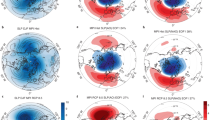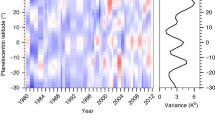Abstract
The principal extratropical atmospheric circulation mode in the Southern Hemisphere, the Antarctic oscillation (or Southern Hemisphere annular mode), represents fluctuations in the strength of the circumpolar vortex and has shown a trend towards a positive index in austral summer in recent decades, which has been linked to stratospheric ozone depletion1,2 and to increased atmospheric greenhouse-gas concentrations3,4. Here we reconstruct the austral summer (December–January) Antarctic oscillation index from sea-level pressure measurements over the twentieth century5 and find that large positive values, and positive trends of a similar magnitude to those of past decades, also occurred around 1960, and that strong negative trends occurred afterwards. This positive Antarctic oscillation index and large positive trend during a period before ozone-depleting chemicals were released into the atmosphere and before marked anthropogenic warming, together with the later negative trend, indicate that natural forcing factors or internal mechanisms in the climate system must also strongly influence the state of the Antarctic oscillation.
This is a preview of subscription content, access via your institution
Access options
Subscribe to this journal
Receive 51 print issues and online access
$199.00 per year
only $3.90 per issue
Buy this article
- Purchase on Springer Link
- Instant access to full article PDF
Prices may be subject to local taxes which are calculated during checkout

Similar content being viewed by others
References
Thompson, D. J. & Solomon, S. Science 296, 895–899 (2002).
Gillett, N. P. & Thompson, D. W. J. Science 302, 273–275 (2003).
Stone, D. A., Weaver, A. J. & Stouffer, R. J. J. Clim. 14, 3551–3565 (2001).
Kushner, P. J. et al. J. Clim. 14, 2238–2249 (2001).
Jones, P. D. Int. J. Climatol. 11, 585–607 (1991).
Jones, J. M. & Widmann, M. J. Clim. 16, 3511–3524 (2003).
Marshall, G. J. J. Clim. 16, 4134–4143 (2003).
Author information
Authors and Affiliations
Corresponding author
Ethics declarations
Competing interests
The authors declare no competing financial interests.
Supplementary information
Supplementary Methods
This file describes the data and methods used to produce the two reconstructions of the Antarctic Oscillation. (DOC 28 kb)
Supplementary Table 1
This file contains a listing of the stations used to produce the two reconstructions and their latitudes and longitudes. (DOC 23 kb)
Rights and permissions
About this article
Cite this article
Jones, J., Widmann, M. Early peak in Antarctic oscillation index. Nature 432, 290–291 (2004). https://doi.org/10.1038/432290b
Published:
Issue Date:
DOI: https://doi.org/10.1038/432290b
This article is cited by
-
A pseudoproxy emulation of the PAGES 2k database using a hierarchy of proxy system models
Scientific Data (2023)
-
Simulation of the Northern and Southern Hemisphere Annular Modes by CAMS-CSM
Journal of Meteorological Research (2019)
-
Long-term stationarity of El Niño–Southern Oscillation teleconnections in southeastern Australia
Climate Dynamics (2016)
-
A new species of the cheilostome bryozoan Chiastosella in the Southern Ocean, past and present
Polar Biology (2014)
-
Sensitivity of the southern annular mode to greenhouse gas emission scenarios
Climate Dynamics (2012)
Comments
By submitting a comment you agree to abide by our Terms and Community Guidelines. If you find something abusive or that does not comply with our terms or guidelines please flag it as inappropriate.



